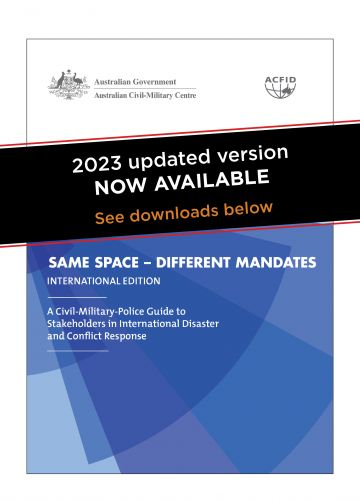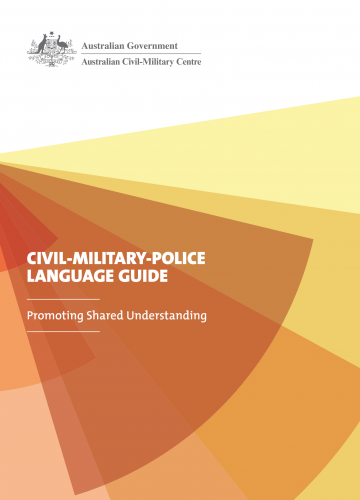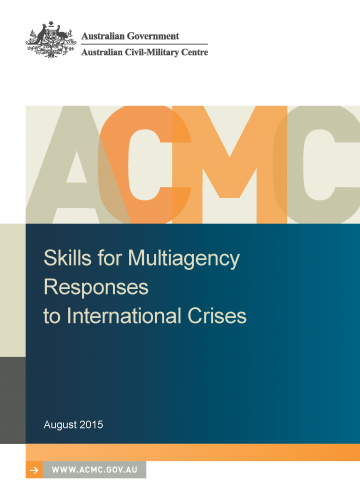Interagency Preparedness
Preparedness refers to the development of the knowledge, capacity and capability required to effectively respond to international, complex emergencies and humanitarian crises. While agencies will have their own policies and programs to develop and maintain agency preparedness, there is a need also to focus on interagency preparedness.
Interagency preparedness is about developing collaborative cultures among civilian, military and police actors, building networks to increase knowledge of respective roles and operations, and increasing the ability of civilian, military and police actors to work together during a conflict or disaster response. Interagency preparedness is an ongoing process and needs continual attention to develop a state of readiness.
Preparedness Framework
The Australian Interagency Preparedness Framework includes five key components of preparedness, with supporting tools and resources as identified.

Planning
Planning includes the frameworks, arrangements and processes for analysing and identifying risks, collating and analysing information and developing strategic and operational plans to prepare for and coordinate responses.
Planning supports interagency effectiveness by:
- establishing goals and priorities
- clarifying roles and responsibilities
- identifying capability requirements
- building understanding of common goals and respective roles.
Planning undertaken by agencies in relation to their own operational response capability can be enhanced by the inclusion of liaison officers from other agencies to facilitate interagency interaction and sharing in the planning process.
Resourcing
Resourcing refers to the mobilisation of human and material resources to support operations. Each agency brings specific and specialised capabilities to an interagency operation, and the particular capabilities each agency contributes for a particular operation is identified in the planning for the operation.
Each agency will identify and develop the required people capabilities and skills and equipment for its contribution to operations. However, to ensure the effectiveness of interagency interaction, these agency resources should include:
- an understanding of the specific roles and contributions of each agency
- an understanding of the operating style, culture and processes of each agency
- organisational and individual capabilities for collaboration
- interoperability of equipment, systems, templates etc.
Training
Civil, military and police organisations have different approaches to training. However, all organisations acknowledge the importance of training to developing and sustaining capacity. Training refers to formal training (courses etc.) as well as informal training (supervision, mentoring and on-the-job training). In the context of preparedness, training takes place within each agency and through joint training.
Agency training addresses the specific capabilities that each agency contributes to operations. Agency training can also address interagency interaction by building awareness of the roles and capabilities and operating context of other agencies, and by developing capabilities in collaboration.
Training together is a key element in strengthening interagency interaction and provides a number of benefits that support interagency interaction, including:
- building awareness and understanding of the capabilities and operating context of other agencies
- providing opportunities to test assumptions and capabilities through course learning processes such as case studies and scenarios
- establishing professional relationships and networks that facilitate trust and working partnerships in future operations.
Exercising
Exercising refers to a range of activities designed to test operational capabilities in planned scenarios. Joint exercises are a key element in building effective interagency interaction and provide a number of benefits, including:
- identifying strengths, weaknesses and gaps in interagency interactions, and providing directions for improvement
- building awareness and understanding of the capabilities and operating context of other agencies
- establishing professional relationships and networks that facilitate trust and working partnerships in future operations.
Exercising requires a significant investment of time and resources from agencies across the planning, implementation and evaluation of an exercise, and agencies may need to prioritise their involvement in exercises. The ACMC supports agency participation in exercises through the ATLAS approach—Advice, Training, Lessons, Advocacy and Support.
Learning
Capturing lessons learned from operations, exercising and other interagency activities is critical to improving operational effectiveness and interagency interactions. The ACMC has a mandated role to identify whole-of-government lessons learned from civil-military-police coordination in conflicts and natural disasters overseas, particularly in interagency level decision making and coordination.
Lessons learned can identify:
- strengths, weaknesses, gaps and areas for improvement for future preparedness
- barriers, enablers and success factors for effective operations and interagency interaction
- trends and issues between agency-specific lessons learned and lessons focusing on whole-of-government interaction.
The ACMC’s Lessons Program includes a coordinated and collaborative approach to civil-military-police lessons management across Australian government agencies, supported by a methodology for design, monitoring, evaluation, dissemination and implementation.




